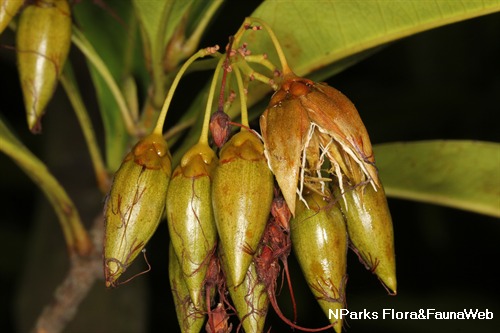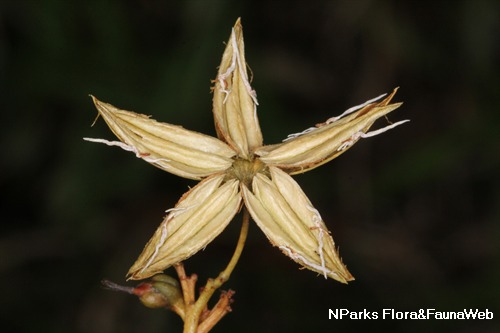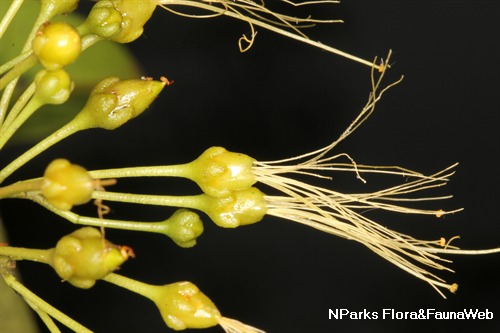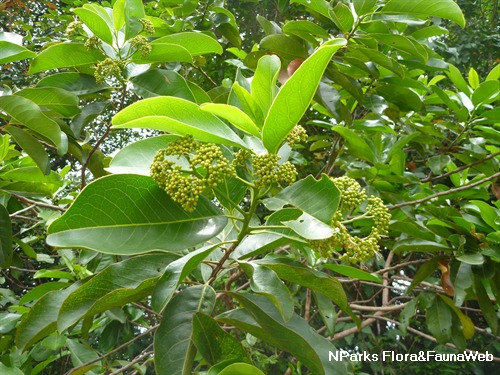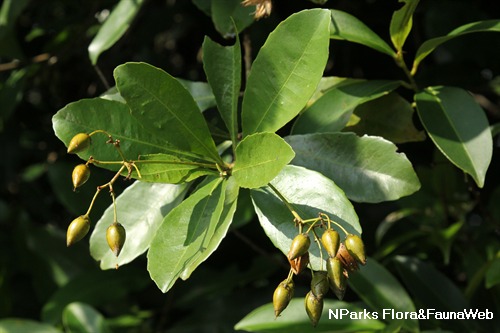
Back
Ixonanthes icosandra Jack
| Family Name: | Ixonanthaceae |
| Common Name: | Pagar Anak Merah, Sangkan Merah |
Name
Classifications and Characteristics
| Plant Division | Angiosperms (Flowering Seed Plants) (Dicotyledon) |
|---|---|
| Plant Growth Form | Tree (Medium (16m-30m)) |
| Lifespan (in Singapore) | Perennial |
| Mode of Nutrition | Autotrophic |
| Plant Shape | Conical |
| Maximum Height | 30 m |
Biogeography
| Native Distribution | Thailand, Sumatra, Peninsular Malaysia, and Singapore |
|---|---|
| Native Habitat | Terrestrial (Primary Rainforest, Secondary Rainforest, Freshwater Swamp Forest) |
| Preferred Climate Zone | Tropical, Sub-Tropical / Monsoonal |
| Local Conservation Status | Native to Singapore (Vulnerable (VU)) |
Description and Ethnobotany
| Growth Form | It is a tree up to 30 m tall, with a dense, conical crown. |
|---|---|
| Foliage | Its spirally arranged, shortly-stalked leaves have upright blades that are narrowly drop-shaped, pale green when young, and 5–19 by 2.5–7.6 cm, with bases tapering to the stalk. The leaves have distantly, finely toothed edges, and rounded, notched or bluntly tipped apices. |
| Flowers | Its flowers are covered with resin, and found in long-stalked, loose clusters from the leaf axils. The flowers are whitish, yellow or green, and 2–3 by 1–2 mm when in full bloom. |
| Fruit | Its woody fruits are up to 20 by 6 mm, ripen green to dark brown, and seated on brown sepals and petals. The ripe fruits split into 5 parts from the top to bottom to reveal winged seeds. Its flat seeds are brown, oval, 10 by 2 mm, and surrounded by yellowish, fleshy fruit pulp. |
| Habitat | It grows in primary and secondary forests on slopes and ridges, from sea-level to 900 m altitude. It occurs locally in the vicinity of MacRitchie Reservoir, in Nee Soon Swamp Forest, and Pulau Ubin. |
| Associated Fauna | Its flowers are insect-pollinated. |
| Cultivation | It can be propagated by seed. |
| Etymology | Greek ixos, birdlime; Greek anthos, flower, referring to the sticky flowers; Greek eikosi, twenty; Greek andes, men, referring to the number of stamens the male plants produce |
| Ethnobotanical Uses | Medicinal: The leaves and roots are
used in traditional medicine. Timber & Products: The timber is not very durable, but used to build houses. Others: The bark is used to tan fish-nets. |
Landscaping Features
| Landscaping | It is suitable for parks. |
|---|---|
| Landscape Uses | General, Parks & Gardens |
Fauna, Pollination and Dispersal
| Pollination Method(s) | Biotic (Fauna) |
|---|---|
| Seed or Spore Dispersal | Abiotic |
Plant Care and Propagation
| Light Preference | Full Sun, Semi-Shade |
|---|---|
| Water Preference | Moderate Water |
| Plant Growth Rate | Moderate |
| Rootzone Tolerance | Moist Soils, Well-Drained Soils, Fertile Loamy Soils |
| Maintenance Requirements | Moderate |
| Propagation Method | Seed |
Foliar
| Foliage Retention | Evergreen |
|---|---|
| Mature Foliage Colour(s) | Green |
| Foliar Type | Simple / Unifoliate |
| Foliar Arrangement Along Stem | Spiral |
| Foliar Attachment to Stem | Petiolate |
| Foliar Shape(s) | Non-Palm Foliage (Obovate) |
| Foliar Venation | Pinnate / Net |
| Foliar Margin | Serrate / Toothed |
| Foliar Apex - Tip | Rounded |
| Leaf Area Index (LAI) for Green Plot Ratio | 3.0 (Tree - Intermediate Canopy) |
Floral (Angiosperm)
| Flower & Plant Sexuality | Bisexual Flowers |
| Flower Colour(s) | Cream / Off-White, Green - Light Green, White, Yellow / Golden |
|---|---|
| Flower Grouping | Cluster / Inflorescence |
| Flower Location | Axillary |
Fruit, Seed and Spore
| Mature Fruit Colour(s) | Brown |
|---|---|
| Fruit Classification | Simple Fruit |
| Fruit Type | Dehiscent Dry Fruit , Capsule |
Image Repository
Others
| Master ID | 1680 |
|---|---|
| Species ID | 2973 |
| Flora Disclaimer | The information in this website has been compiled from reliable sources, such as reference works on medicinal plants. It is not a substitute for medical advice or treatment and NParks does not purport to provide any medical advice. Readers should always consult his/her physician before using or consuming a plant for medicinal purposes. |

